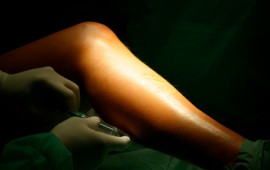Varicose Veins: Symptoms and Causes
Author: Shannon Miller Lifestyle

Varicose veins are twisted enlarged veins that are most commonly seen in feet and legs.
Veins that are dark purple or blue in color, and veins that are appear twisted and bulging are signs that you probably have varicose veins.
For many varicose veins are very mild and just cause a cosmetic inconvenience, but for others this condition can be very painful and can cause a lot of discomfort that can lead to more serious circulatory problems.
Do I have spider veins or Varicose veins?
Spider veins are smaller and usually do not bulge and knot at the skin. They can be bluish or reddish in color, look as though they spider the skin, and are the predecessor to varicose veins.
Varicose veins bulge and can be painful. The cause of the pain is the damage within the larger vein that supplies the smaller veins. As the blood pulsates through to the smaller veins, the damage makes the veins swell and hurt.
Some painful symptoms of varicose veins that you can experience may be:
- An achy or heavy feeling in your legs
- Burning, throbbing, muscle cramping and swelling in your lower legs
- Worsened pain after sitting or standing for a long time
- Itching around one or more of your veins
- Skin ulcers near your ankle, which can mean you have a serious form of vascular disease that requires medical attention
Some common causes of varicose veins:
Varicose veins are quite simply caused by a damage to the veins themselves. They usually occur in the legs or lower extremities because it takes power for the blood to pulsate upward and back to the heart. Changes in the body cause changes in the veins themselves. Age, hormone changes, pregnancy, or obesity can change the way the body pushes blood back up to the heart and has a great impact on varicose veins.
- Age. As you get older, your veins tend to lose elasticity causing them to stretch. The valves in your veins may become weak, allowing blood that should be moving toward your heart to flow backward. Blood pools in your veins, and your veins enlarge and become varicose. The veins appear blue because they contain deoxygenated blood, which is in the process of being recirculated through the lungs.
- Pregnancy. Some pregnant women develop varicose veins. Pregnancy increases the volume of blood in your body, but decreases the flow of blood from your legs to your pelvis. This circulatory change is designed to support the growing fetus, but it can produce an unfortunate side effect — enlarged veins in your legs.
There are other factors that can play a part in developing varicose veins, such as family history, obesity and standing or sitting for a long period of time.
Do I need to worry about my spider veins or varicose veins?
Dr. Lonnie L Whiddon of Dallas Vein Specialists says that people are not concerned enough about their spider and varicose veins. “Doctors often tell their pregnant patients not to worry about their varicose veins,” he says, “Instead, realize that varicose veins are a result of damage in the supply vein in the leg. Disregarding this and letting the vein continue to pulse into the smaller veins only creates more of a problem.” For this reason, Dr. Whiddon and others like him prefer early intervention.
Are Varicose Veins Dangerous?
They can be. With a higher risk of varicose veins comes a higher risk of leg blood clots, as the blood has a hard time circumventing the blood flow area. Leg blood clots can cause heart attacks or strokes.
If I want Varicose Vein treatments, what are my options?
Dr. Whiddon and many others now are using CoolTouch Laser Systems to target the supply vein that causes varicose veins. Using ultrasound, they can find the source of the problem, and then inject the source of the problem vessel. By attacking the problem rather than the subsequent vessels, return of problems are less likely. Doctors and patients using the CoolTouch System say that the treatment is not as painful as a typical varicose vein treatment and causes little to no down time with the patient. The ultrasound is used to find the source of the problem, and a simple injection of the supply vein quickly shuts down the problem. The body then can absorb the smaller, damaged veins.
Many clinics offer various laser treatments, and many offer vein stripping. With new procedures available, vein stripping, a very painful procedure, can usually be avoided.
Sclerotherapy is a common treatment, where the blood vessel is injected with a substance that stops blood flow through it. The result is a block of that vessel. The body creates a flow through a different vessel and does not damage the limb by going around the original vessel. The body eventually consumes and discards the unused vessel.
